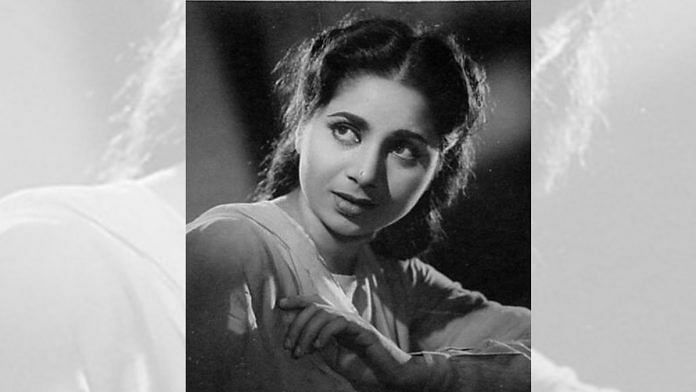Geeta Bali was only 12 when she started off her career as a child actor in The Cobbler. Just a few years later, she made her debut as a heroine in Majnu’s Badnami (1946), shot in pre-Partition Punjab. However, it was acting opposite Bharat Bhushan and Begum Para in the love-triangle hit Suhaag Raat (1948) that put her on the map of Hindi cinema.
The film’s director and producer, Kishor Sharma, is known to have been particularly impressed with Bali’s “verve and exuberance”. According to her actor husband Shammi Kapoor, Bali financially sustained her family.
On her 55th death anniversary, ThePrint takes a look at how she built her career from scratch and married into the famous Kapoor family of Hindi cinema, continuing to act right up until her untimely death.
Her prophetic words for Rajesh Khanna
Geeta Bali, originally Harikirtan Kaur, was born in 1930 in Sargodha, Punjab, into a family of limited means. According to her son Aditya, she was “an almost uneducated woman” who “grew up in penury and died before she could enjoy a good life”.
She acted in 70 films over a 10-year career, and quickly rose to fame in the late 1940s and 1950s. Given how she acted in a range of genres, whether tragedy, drama or comedy, Bali never fell into the trap of a typecast.
Apart from her captivating on-screen presence, Bali was a talented, lively dancer, classically trained as a child. She showcased her talents in Guru Datt’s Baazi (1951) and the blockbuster musical, Albela. In Albela, she and co-actor Bhagwan Dada famously danced to Shola Jo Bhadke. Actor Dev Anand, who acted opposite Bali in Baazi, often mentioned how people would flock to watch her perform Tadbeer se bigdi hui.
Her emphatic portrayal of a blind girl in Sohrab Modi’s Jailor substantiated her reputation as a ‘dramatic queen’. However, drama seemed to evade her personal life and she was known to be mature and down-to-earth, and if she liked someone, she would try to help them.
Yasser Usman, in his biography of late superstar Rajesh Khanna, describes how Khanna used to attend rehearsals for plays in Bombay in the same building where Bali’s office was located. This was back in his theatre days when he’d go by his original name, Jatin. He was “tongue-tied” when he met Bali for the first time.
Learning of his dreams to be in Bollywood, she attempted to land Jatin a role in a “Punjabi film” she was working on at the time (presumably Rajinder Singh Bedi’s Rano). When Dharmendra was cast in the film instead, she reportedly invited Jatin to the film’s launch party at her Bombay home and told him, “The sky is filled with stars…One day you will shine too.”
Also read: Remembering Homai Vyarawalla, self-taught firebrand photographer who made her own rules
Married life with Shammi Kapoor
Bali and Shammi Kapoor had worked together in projects like Kedar Kapoor’s Miss Coca Cola and Hari Walia’s Coffee House. Shooting Kishor Sharma’s Rangeen Raatein (1955) in the romantic hill station of Ranikhet, however, was when the two actors fell in love, Kapoor once said in an interview. Bali and he had a mutual admiration for the scenic place, he recalled. He added that she refused multiple proposals from him until August of 1955, but when she agreed, she didn’t want to wait. The two spontaneously tied the knot in Mumbai’s Banganga temple.
Interestingly, Bali had earlier acted opposite her father-in-law Prithviraj Kapoor in Anand Math (1952).
In a 2011 interview with The Times of India, Aditya described his mother as “the only woman who could punch my Dad and get away with it”. He also mentioned how when he was growing up in a boarding school, his mother would visit more than his father though both parents’ careers were soaring at the time. Bali apparently “mothered” his schoolmates too, so much so that when she passed away his whole class mourned. She “was the original Sridevi”, he added.
An abrupt death
Bali’s life and short, prolific career came to an abrupt end on 21 January 1965. She had contracted smallpox while shooting Rano, a film based on the novella Ek Chadar Maili Si by Rajinder Singh Bedi about a widow’s marriage to her late husband’s brother.
Elaborating on the last days with his mother, Aditya said, “My mother was gone in just 15 days. I had gone on location in rural Punjab where she contracted smallpox… …My mom had picked me up from boarding school and taken me to the location. I spent the whole month with her. Then she fell ill. My father left his own shoot and picked both of us up. Her condition got worse and finally she died. Dad was doing Teesri Manzil at that time.”
Bali was only 34 at the time.
Bali’s death reportedly caused the author to shelve the film until it was revived in 1946. It starred Hema Malini, who played the role meant for Bali, and Rishi Kapoor, Shammi’s nephew.
Also read: Farooq Sheikh, the Jack of all trades — theatre, TV, films and secret philanthropy







Geeta Bali was the daughter of a philosopher known as Kartar Singh and the family lived in Amritsar. She was not born in Sargodha. Sargodha was a very backward area compared to Lahore and Amritsar. She could learn horse riding and swimming in Amritsar. Amritsar Cantonment had horses and trainers and the Khalsa College has one of India’s oldest Olympic sized swimming pool.
He was no Kishor Sharma, he was the great writer, lyricist, producer, director late Kidar Sharma who left his own mark in Bollywood. In his Rangeen Raate where Shammi Kapoor and Mala Sinha were in the lead, she sportingly did the role of a male.